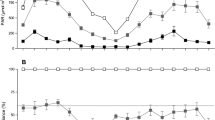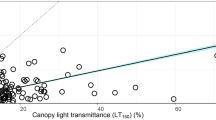Abstract
Canopy tree recruitment is inhibited by evergreen shrubs in many forests. In the southern Appalachian mountains of the USA, thickets of Rhododendron maximum L. restrict dominant canopy tree seedling survival and persistence. Using R. maximum as a model system, we examined available light under the thickets and the photosynthetic responses of seedlings of canopy tree species. We tested the hypothesis that the additional shading from under R. maximum drives carbon gain in seedlings below the threshold for growth and survival. A reduction in light under the thicket was found where canopy openness (derived from canopy photographs) under R. maximum was half the amount measured in forest without R. maximum. R.␣maximum also reduced direct radiation by 50% and diffuse radiation by 12–29% compared to forest without the shrub layer. Mean mid-day PPFD (photosynthetically active photon flux density between 1000 and 1400 h) under R. maximum (obtained from quantum sensors) was below 10 \(\upmu\)mol m−2 s−1 on both clear and overcast days and the amount of sunflecks greater than 10 \(\upmu\)mol m−2 s−1 PPFD was only 0–20 min per day. In contrast, forest without R. maximum received a mean PPFD of 18–25 \(\upmu\)mol m−2 s−1 on clear days and a cumulative sunfleck duration of 100–220 min per day in all sky conditions. Consistent with light availability between the sites, daily carbon gain in Quercus rubra L. seedlings was lower in forest with R. maximum compared to forest where the shrub was absent. The presence of the shrub layer also significantly suppressed average mid-day photosynthesis of both Q. rubra and Prunus serotina Ehrt. seedlings on 8 out of 11 measurement dates. However, parameters derived from light response curves between seedlings growing in forest sites with or without a thicket of R. maximum was significantly different only in A max (maximum photosynthetic rate), indicating a lack of further acclimation to the deeper shade under R. maximum. While the additional shade cast by R. maximum is sufficient to prevent the regeneration of tree seedlings under this shrub, there was sufficient heterogeneity in light under the thicket to imply that deep shade only partially explains the complete inhibition of regenerating canopy trees under R. maximum.
Similar content being viewed by others
References
Anderson M.C. (1964). Studies of the woodland light environment. I. The photographic computation of light conditions. Journal of Ecology 52: 27–41
Bazzaz F.A. (1979). The physiological ecology of plant succession. Annual Review of Ecology and Systematic 10: 351–372
Beier C.M., Horton J.L., Walker J.F., Clinton B.D., Nilsen E.T. (2005). Carbon limitation leads to suppression of first year oak seedling beneath evergreen understory shrubs in Southern Appalachian hardwood forests. Plant Ecology 176:131–142
Canham C.D. (1985). Suppression and release during canopy recruitment in Acer saccharum. Bulletin of the Torrey Botanical Club 112: 134–145
Canham C.D. (1989). Differences responses to gaps among shade tolerant tree species. Ecology 70:560–562
Canham C.D. (1990). Suppression and release during canopy recruitment in Fagus grandifolia. Bulletin of the Torrey Botanical Club 117: 1–7
Canham C.D., Finzi A.C., Pacala S.W., Burbank D.H. (1994). Causes and consequences of resource heterogeneity in forests: interspecific variation in light transmission by canopy trees. Canadian Journal of Forest Research 24: 337–349
Chazdon R.L. (1988). Sunflecks and their importance to forest understorey plants. Advances in Ecological Research 18: 1–63
Chazdon R.L., Fetcher N. (1984). Photosynthetic light environment I a lowland tropical rain forest in Costal Rica. Journal of Ecolology 72: 553–564
Chazdon R.L., Field C.B. (1987). Photographic estimation of photosynthetically active radiation: evaluation of a computerized technique. Oecologia 73: 525–532
Clark D.B., Clark D.A., Rich P.M. (1993). Comparative analysis of microhabitat utilization by saplings of nine tree species in a neotropical rain forest. Biotropica 25: 397–401
Constabel A.J., Lieffers V.J. (1996). Seasonal patterns of light transmission through boreal mixedwood canopies. Canadian Journal of Forest Research 26: 1008–1014
Cross J.R. (1981). The establishment of Rhododendron ponticum in the Killarney oakwoods, S.W. Ireland. Journal of Ecology 69: 807–824
Day F.P., Jr., Phillips D.L., Monk C.D. (1988). Forest communities and patterns. In: Swank W.T., Crossley D.A. (eds), Forest Hydrology and Ecology at Coweeta. Springer, Berlin, pp. 141–150
Dobbs M.M. (1995). Spatial and temporal distribution of the evergreen understorey in the southern Appalachians. University of Georgia, Athens, GA
Easter M.J., Spies T.A. (1994). Using hemispherical photography for estimating photosynthetic photon flux density under canopies and in gaps in Douglas-fir forests of the Pacific Northwest. Canadian Journal of Forest Research 24: 2050–2058
Ellsworth D.S., Reich P.B. (1992). Water relations and gas exchange of Acer saccharum seedlings in contrasting natural light and water regimes. Tree Physiololgy 10: 1–20
Farrar J.L. (1995). Trees in Canada. Canadian Forest Service, Ottawa
Fladeland M.M., Ashton M.S., Lee X. (2003). Landscape variations in understory PAR for a mixed deciduous forest in New England, USA. Agricultural and Forest Meterology 118: 137–141
Gates D.M. (1980). Biophysical Ecology. Springer-Verlag, Berlin
Groninger J.W., Seiler J.R., Peterson J.A., Kreh R.E. (1996). Growth and photosynthetic responses of four Virginia Piedmont tree species to shade. Tree Physiology 16: 773–778
Jennings S.B., Brown N.D., Sheil D. (1999). Assessing forest canopies and understorey illumination: canopy closure, canopy cover and other measures. Forestry 72: 59–73
Johnson J.D., Tognetti R., Michelozzi M., Pinzauti S., Minotta G., Borghetti M. (1997). Ecophysiological responses of Fagus sylvatica seedlings to changing light conditions. II. The interactions of light environment and soil fertility on seedling physiology. Physiologia Plantarum 101: 124–134
Jones R.H., McLeod K.W. (1990). Growth and photosynthetic responses to a range of light environments in Chinese tallowtree and Carolina ash seedlings. Forestry Science 36: 851–862
Kobe R.K., Pacala S.W., Silander J.A., Jr. (1995). Juvenile tree survivorship as a component of shade tolerance. Ecological Application 5: 517–532
Larcher W. (1995). Physiological Plant Ecology. Springer, Berlin
Lei T.T., Koike T. (1998). Functional leaf phenotypes for shaded and open environments of a dominant dwarf bamboo (Sasa senanensis) in northern Japan. International Journal of Plant Sciences 159: 812–820
Lei T.T., Semones S.W., Walker J.F., Clinton B.D., Nilsen E.T. (2002). Effects of Rhododendron maximum thickets on tree seed dispersal, seedling morphology, and survivorship. International Journal of Plant Sciences 163: 991–1000
Lipscomb M.V., Nilsen E.T. (1990). Environmental and physiological factors influencing the natural distribution of evergreen and deciduous ericaceous shrubs on northeast and southwest slopes of the southern Appalachian mountains. I. Irradiance tolerance. American Journal of Botany 77: 108–115
Machado J.-L., Reich P.B. (1999). Evaluation of several measures of canopy openness as predictors of photosynthetic photon flux density in deeply shaded conifer-dominated forest understory. Canadian Journal of Forest Research 29: 1438–1444
Midgley G.F., Rutherford M.C., Davis G.W., Bosenberg J.deW. (1992). Photosynthetic response of heliophilous Rhus species to environmental modification by invasive shrubs. Functional Ecology 6: 334–345
Mitchell A.K., Arnott J.T. (1995). Effects of shade on the morphology and physiology of amabilis fir and western hemlock seedlings. New Forests 10:79–98
Mitchell P.L. and Whitmore T.C. 1993. Use of hemispherical photographs in forest ecology. O.F.I. Occasional papers No. 44. Oxford Forestry Institute
Monk C.D., Day F.P., Jr. (1985). Vegetation analysis, primary production and selected nutrient budgets for a southern Appalachian oak forest: a synthesis of IBP studies at Coweeta. Forest Ecology and Management 10: 87–113
Nilsen E.T., Orcutt D.M. (1997). Physiology of Plants Under Stress: Abiotic Factors. John Wiley and Sons, New York
Nilsen E.T., Walker J.F., Miller O.K., Semones S.W., Lei T.T., Clinton B.D. (1999). Inhibition of seedling survival under Rhododendron maximum (Ericaceae): Could allelopathy be a cause?. American Journal of Botany 6: 1957–1605
Nilsen E.T., Clinton B.D., Lei T.T., Miller O.K., Semones S.W., Walker, J.F. (2001). Does Rhododendron maximum L. (Ericaceae) reduce the availability of resources above and belowground for canopy tree seedlings?. American Midland Naturalist 145: 325–343
Oberbauer S.F., Clark D.B., Clark D.A., Rich P.M., Vega G. (1993). Light environment, gas exchange, and annual growth of saplings of three species of rain forest trees of Costa Rica. Journal of Tropical Ecology 9: 511–523
Pearcy R.W., Pfisch W.A. (1993). The consequences of sunflecks for photosynthesis and growth of forest understory plants. In: Schulze E-D., Caldwell M.M. (eds), Ecophysiology of Photosynthesis. Springer-Verlag, Berlin, pp. 343–359
Pfitsch W.A., Pearcy R.W. (1989). Steady-state and dynamic photosynthetic response of Adenocaulon bicolor (Asteraceae) in its redwood forest habitat. Oecologia 80: 471–476
Rich P.M. (1989). A manual for analysis of hemispherical canopy photography. Manual LA-11733-M, Los Alamos National Laboratory, Los Alamos, NM
Rich P.M. (1990). Characterizing plant canopies with hemispherical photographs. Remote Sensing Reviews 5: 13–29
Rich P.M., Clark D.B., Clark D.A., Oberbauer S.F. (1993). Long-term study of solar radiation regimes in a tropical wet forest using quantum sensors and hemispherical photographs. Agricultural and Forest Meteorology 65: 107–127
Roxburgh J.R., Kelly D. (1995). Uses and limitations of hemispherical photography for estimating forest light environments. New Zealand Journal of Ecology 19: 213–217
Smith A.P., Hogan K.P., Idol J.R. (1992). Spatial and temporal patterns of light and canopy structure in a lowland tropical moist forest. Biotropica 24: 503–511
Swank W.T., Crossley D.A. Jr. (eds). (1988). Forest Hydrology and Ecology at Coweeta. Springer-Verlag, New York
Takenaka A. (1986). Comparative ecophysiology of two representative Quercus species appearing in different stages of succession. Ecological Research 1: 129–140
Turner I.M. (1990). Tree seedling growth and survival in a Malaysian rain forest. Biotropica 22: 146–154
Walker J.F., Lei T.T., Semones S.W., Nilsen E.T., Clinton B.D., Miller O.K. (1999). Suppression of ectomycorrhizae on canopy tree seedlings in Rhododendron maximum L. (Ericaceae) thickets in the southern Appalachian mountains. Mycorrhizae 9: 49–56
Walters M.B., Reich P.B. (1996). Are shade tolerance, survival and growth linked? Low light and nitrogen effects on hardwood seedlings. Ecology 77: 841–853
Watling J.R., Ball M.C., Woodrow, I.E. (1997). The utilization of lightflecks for growth in four Australian rain-forest species. Functional Ecology 11: 231–239
Whitmore T.C., Brown N.D., Swaine M.D., Kennedy D., Goodwin-Bailey C.I., Gong W.-K. (1993). Use of hemispherical photographs in forest ecology: measurement of gap size and radiation totals in a Bornean tropical rain forest. Journal of Tropical Ecology 9: 131–151
Acknowledgements
This study was funded by USDA Forest/Range/Crop/Wetland Ecosystems Program, Grant # 95–37101–1902. Logistical assistance was provided by USDA Forest Service, Coweeta Hydrologic Laboratory. The use of a fisheye lens was kindly provided by Y. Maruyama. Canopy photo images were analyzed using FEW 4.0, a PC-based software developed by M. Ishizuka of Forestry and Forest Products Research Institute, Tsukuba, Japan.
Author information
Authors and Affiliations
Corresponding author
Rights and permissions
About this article
Cite this article
Lei, T.T., Nilsen, E.T. & Semones, S.W. Light environment under Rhododendron maximum thickets and estimated carbon gain of regenerating forest tree seedlings. Plant Ecol 184, 143–156 (2006). https://doi.org/10.1007/s11258-005-9058-3
Received:
Accepted:
Published:
Issue Date:
DOI: https://doi.org/10.1007/s11258-005-9058-3




